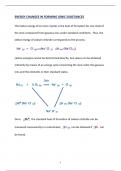Born haber cycle Study guides, Revision notes & Summaries
Looking for the best study guides, study notes and summaries about Born haber cycle? On this page you'll find 50 study documents about Born haber cycle.
Page 3 out of 50 results
Sort by
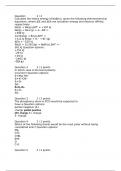
-
CHEM133 Week 16 Final Exam (Summer)
- Exam (elaborations) • 11 pages • 2023
-
- £25.40
- + learn more
1. Question: Calculate the lattice energy of NaBr(s), given the following thermochemical equations, where ΔIE and ΔEA are ionization energy and electron affinity, respectively. 2. Question: In which case is the bond polarity incorrect? 3. Question: The phosphorus atom in PCl3 would be expected to have a 4. Question: Which of the following bonds would be the most polar without being considered ionic? 5. Question: Calculate the standard enthalpy of formation (ΔHformation) for LiCl(s) given ...
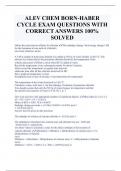
-
ALEV CHEM BORN-HABER CYCLE EXAM QUESTIONS WITH CORRECT ANSWERS 100% SOLVED
- Exam (elaborations) • 6 pages • 2024
-
- £8.06
- + learn more
ALEV CHEM BORN-HABER CYCLE EXAM QUESTIONS WITH CORRECT ANSWERS 100% SOLVED Define the term electron affinity for chlorine The enthalpy change / heat energy change / ΔH for the formation of one mole of (chloride) ions from (chlorine) atoms A 5.00 g sample of potassium chloride was added to 50.0 g of water initially at 20.0 °C. The mixture was stirred and as the potassium chloride dissolved, the temperature of the solution decreased. Start a clock when KCl is added to water Record ...
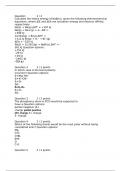
-
CHEM133 Week 16 Final Exam
- Exam (elaborations) • 11 pages • 2023
- Available in package deal
-
- £34.49
- + learn more
1. Question: Calculate the lattice energy of NaBr(s), given the following thermochemical equations, where ΔIE and ΔEA are ionization energy and electron affinity, respectively. 2. Question: In which case is the bond polarity incorrect? 3. Question: The phosphorus atom in PCl3 would be expected to have a 4. Question: Which of the following bonds would be the most polar without being considered ionic? 5. Question: Calculate the standard enthalpy of formation (ΔHformation) for LiCl(s) given ...
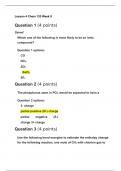
-
CHEM133 Week 9 Lesson 4 Quiz
- Exam (elaborations) • 12 pages • 2023
-
- £15.72
- + learn more
1. Question: Which one of the following is most likely to be an ionic compound? 2. Question: The phosphorus atom in PCl3 would be expected to have a 3. Question: The phosphorus atom in PCl3 would be expected to have a give CH3Cl and hydrogen chloride. 4. Question: How many of the following molecules have no dipole moment? 5. Question: Atoms having equal or nearly equal electronegativities are expected to form 6. Question: Element A has an electronegativity of 0.8 and element B has an electr...
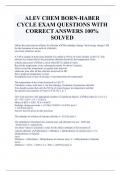
-
ALEV CHEM BORN-HABER CYCLE EXAM QUESTIONS WITH CORRECT ANSWERS 100% SOLVED
- Exam (elaborations) • 6 pages • 2024
-
- £6.85
- + learn more
ALEV CHEM BORN-HABER CYCLE EXAM QUESTIONS WITH CORRECT ANSWERS 100% SOLVED Define the term electron affinity for chlorine The enthalpy change / heat energy change / ΔH for the formation of one mole of (chloride) ions from (chlorine) atoms A 5.00 g sample of potassium chloride was added to 50.0 g of water initially at 20.0 °C. The mixture was stirred and as the potassium chloride dissolved, the temperature of the solution decreased. Start a clock when KCl is added to water Record ...
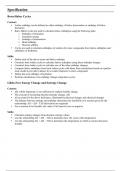
-
AQA A Level Chemistry - Unit 3.1.8: Thermodynamics - Full Notes
- Summary • 8 pages • 2023
-
- £3.99
- + learn more
Detailed and comprehensive notes on unit 3.1.8 (thermodynamics) for AQA A level chemistry. Covers: enthalpy change definitions, born haber cycles, the perfect ionic model, entropy, Gibb’s free energy, enthalpies of solution and feasibility.
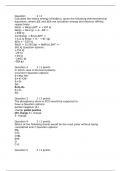
-
CHEM133 Week 16 Final Exam (Summer)
- Exam (elaborations) • 11 pages • 2023
-
- £19.75
- + learn more
1. Question: Calculate the lattice energy of NaBr(s), given the following thermochemical equations, where ΔIE and ΔEA are ionization energy and electron affinity, respectively. 2. Question: In which case is the bond polarity incorrect? 3. Question: The phosphorus atom in PCl3 would be expected to have a 4. Question: Which of the following bonds would be the most polar without being considered ionic? 5. Question: Calculate the standard enthalpy of formation (ΔHformation) for LiCl(s) given ...
This document gives details of how the Born Haber Cycle of Sodium Chloride can be calculated. It includes the drawing of the Born Haber Cycle and the lattice enthalpy of Sodium Chloride.
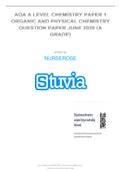
-
AQA A LEVEL CHEMISTRY PAPER 1 ORGANIC AND PHYSICAL CHEMISTRY QUESTION PAPER JUNE 2020
- Other • 35 pages • 2022
-
- £12.90
- + learn more
AQA A LEVEL CHEMISTRY PAPER 1 ORGANIC AND PHYSICAL CHEMISTRY QUESTION PAPER JUNE 2020 Paper 1 Inorganic and Physical Chemistry Tuesday 2 June 2020 Afternoon Time allowed: 2 hours Materials For this paper you must have: • the Periodic Table/Data Booklet, provided as an insert (enclosed) • a ruler with millimetre measurements • a scientific calculator, which you are expected to use where appropriate. Instructions • Use black ink or black ball-point pen. • Fill in the b...
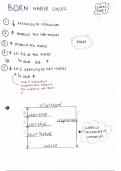
-
Born Haber Cycles - Unit 3.1.8 - Thermodynamics (Chemistry AQA A-Level)
- Summary • 1 pages • 2023
- Available in package deal
-
- £3.49
- + learn more
A summary of Born Haber Cycles in Thermodynamics- Unit 3.1.8. Chemistry A-level AQA.

How did he do that? By selling his revision notes on Stuvia. Try it yourself! Discover all about earning on Stuvia



